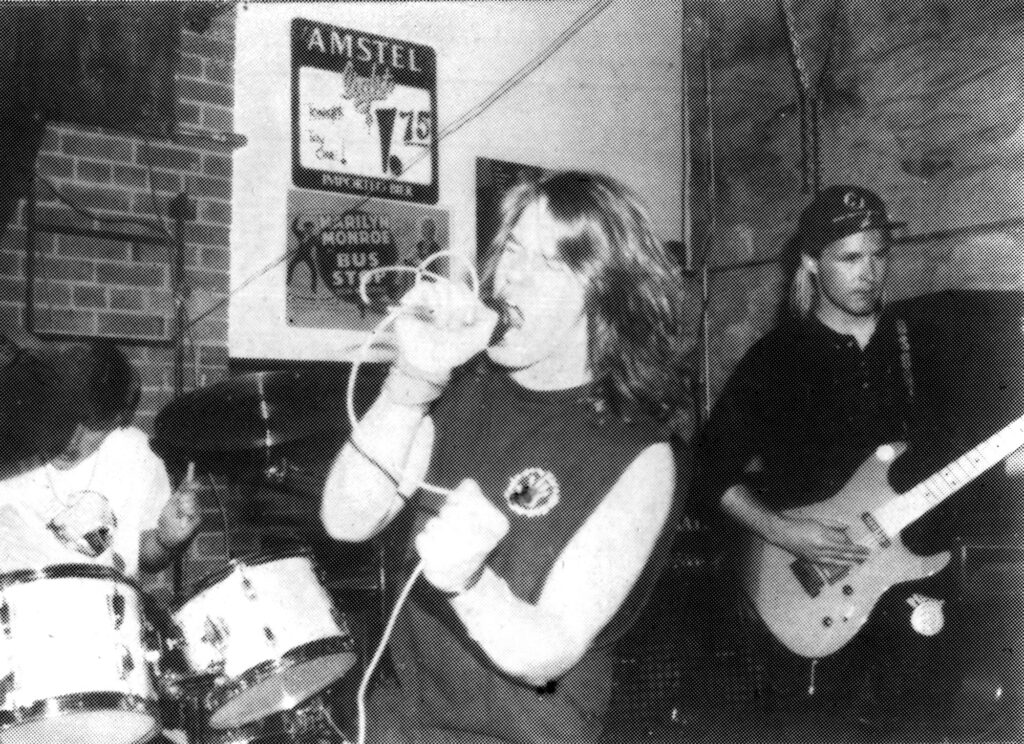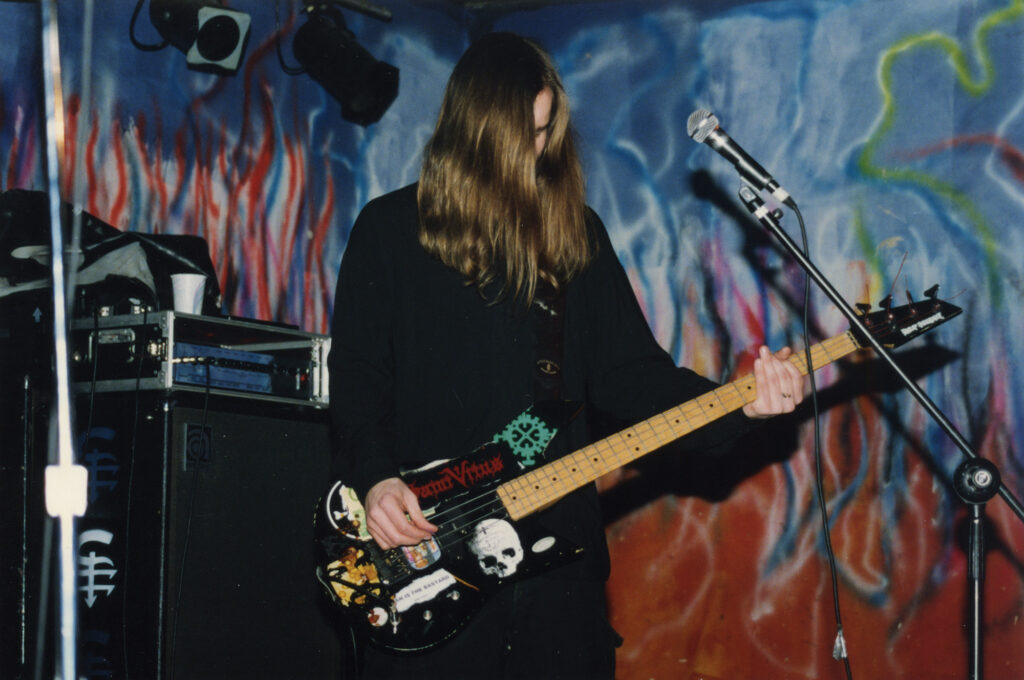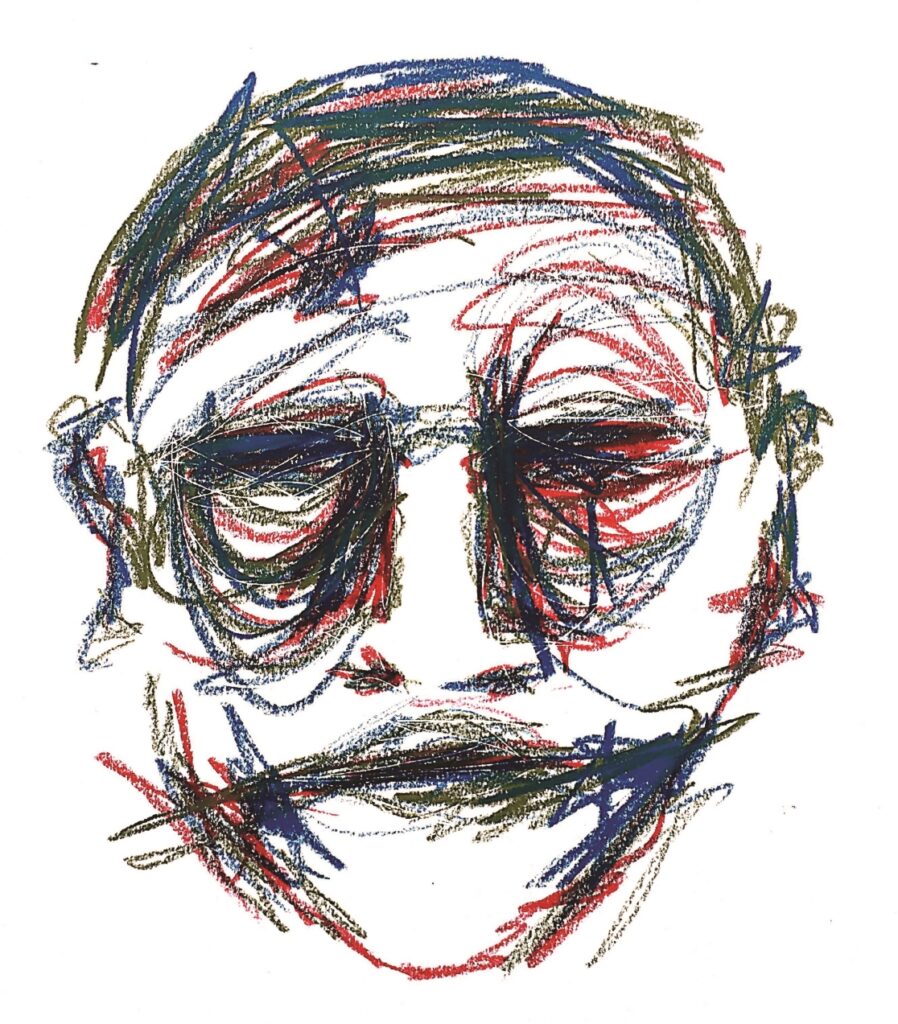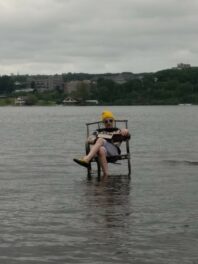Jonathan Canady is an American artist and musician, who has released a number of works with bands and solo; along with having his art exhibited at galleries across the world. Born in 1972, in Denver, Colorado, USA, he played in a variety of underground bands before helping form the extreme metal outfit Dead World, in 1991.
After Dead World’s break-up, Jonathan went on to tinker with even harsher sounds via his first solo project Deathpile around 1995 – releasing that project’s magnum opus, the ‘G.R.’ LP in 2003. After some time, he put Deathpile aside, but continued to perform under a number of names, including simply his own.

Jonathan currently lives in Portland, OR, with his long-time significant other Suzie Assault Rifle, and their beloved kitty Enid. He has released a number of zines and art books, and keeps himself busy staying creative in a variety of mediums.
As an artist whose output I enjoy and admire, I thought it would be interesting to take a look at his work, past and present.
Take a read of my interview with him, below…
As a musician, you pretty much started out in the death metal scene, correct?
Was Dead World your first band?
Not quite death metal. The first group I was in that played live was called Psychotic Society. This was around 1988.
We were just an awful thrash band. The drummer Carl and bassist Brian wouldn’t let the singer do his death metal growl, so yeah… thrash. Since Carl was the only really talented member, and we practiced in his parent’s garage, Matt and I didn’t argue. There are no hard feelings though. All four of us are still in touch.
After that group broke up I was in a hardcore crossover band called Velcro Overdose. We opened for Green Day, when no one cared about them, and we did a 7” EP as the very first Relapse Records release.
It’s very silly stuff, but we had fun.

Photo by Kurt Hubert.


The debut release from lauded record label Relapse Records.
How did Dead World come about?
Kevin Kopp and Greg Knoll from Velcro formed Dead World with me in 1991. We all liked Godflesh and other weird music back then. We didn’t know what the hell we were doing but recorded the first album Collusion anyway.
It’s amazing that Relapse put it out because it is a mess. Greg’s drumming was the best thing about the album, but Kevin and I decided to do another album with a drum machine. We hoped to make a real go of the band and a drummer wouldn’t work into those plans.
That led to ‘The Machine’ sessions.

Photo by Debbie Leonhardt.
How did you get the attention of Relapse Records, and get picked up by them?
Before he founded Relapse, Matt Jacobson and I were best friends and did a death metal / grindcore zine called Horrendified. That was named after the Sore Throat song “Horrendify and Kill.”
Matt came to most of the Velcro live shows and offered to release an EP. It took him YEARS to sell those 500 copies. He was also the singer of Psychotic Society.
We’re still very close friends.
Matt is honestly the most generous person I know, and a great dad.


Did you start the Deathpile project as Dead World were ending, or was it always something you tinkered with before releasing material under that name?
Yes, Deathpile was a band name I came up with as a post-Dead World project. I ended up using it as a song title on the final album ‘Thanatos Descends.’
My good friend Mark Solotroff asked me to do something for a limited tape series on his new label Bloodlust. Dead World was essentially over, so I decided to use Deathpile as a project name and try my hand at fully experimental music.
There were experimental intros and tracks on Dead World albums, but I wanted to go all the way.
What was Deathpile to you?
… and what influenced you in its sonic and graphic output?
It started as me fumbling around with the post-industrial and noise influences I had when I was in my early 20s. I quickly focused in on power electronics and got better at writing and recording with practice.
Eight years of being mostly ignored led to playing a show that Dominick from Hospital Productions attended. He suggested a Green River murder themed album. By the time ‘G.R.’ was finished I realized that there was nowhere left to go without repeating myself.
I am honoured that something I was involved in has gained cult status, but when people bring up the ‘G.R.’ album to me, I am always reminded of Lemmy. In his autobiography he said something like, “People always talk to me about ‘Ace of Spades’. Why don’t they ask what I’m working on now?”

Photo by Kurt Hubert.
The experimental hip hop act clipping. used a Deathpile sample. How did that come about?
clipping. just asked me. They even offered points on royalties, which was a nice gesture. I’m glad I said yes because the track and video for “Body and Blood” are fantastic.
I haven’t made a dime off it, but that is fine. Sub-Pop stopped sending me royalty statements because my cut never got over fifty bucks. I really didn’t expect more than beer money anyhow.
I recently checked out the work they have been putting out since CLPPNG and it is consistently excellent. They’ve created some daring experimental work like “Double Live” that I was really impressed by.
I’m not a rap guy, but clipping. is an undeniable force.
You still perform and release music under many monikers in what most would call industrial or even noise music. Why did you decide to do them under different names, and lay rest to the Deathpile project?
Deathpile was limited to the power electronics and noise worlds. I wanted to be able to try other things.
The main reason for ending that project was that I hated when my favorite bands kept releasing albums after their peak. Slayer is a prime example. ‘South of Heaven’ is a great album, but I would have preferred the band break up after ‘Reign in Blood.’ They would have been even greater legends than they are now.
What does the future hold for you, musically?
No future. Well, not “no future”, but this seems to be a good forum to announce that I am retiring from music to spend more time on art. I will still use sound design for my art from time to time. I can also see doing more art performances like ‘Unbroken Circle‘ or live soundtracks to my video art.
As far as basements, bars, clubs and so on? Nope. I’ve done that for over thirty years.
I want to do performances in a more controlled or special environment from now on. Art without the music business bullshit.
The current system of streaming services and social media promotion on every platform is not for me.
You also do artwork – What was the beginning of your artistic drive, or need to create?
I naively believed I could sell enough original artwork to make a living. Thankfully, I fell in love with making art without compromise.
I realized many years ago that yes, I could draw surreal cute animals and make a living, but ethically that would have been suicide.
Do you have influences on your artistic output?
Who or what are they?
I used to think that by trying to absorb everything I was influenced by I could emulate it.
That never really worked.
Any time my work looked like another artist it just felt depressing.
Now I resist any influences. I am just rolling with where my mind takes me.
The other day someone asked me what artists inspired my work, and when I said some names out loud I realized it wasn’t true anymore.
I still love looking at art, and sometimes still use source material as a starting point. However all the influences get blended into such a mixture with the other things rattling around in my head that it would be hard to recognize them again in my work.



Published 2023, in collaboration with Public Collectors.
How did your collaboration with John Duncan come about, and what came to fruition out of that?
In 2019 I found out that John Duncan appreciated a solo art show of mine in Bologna, Italy. He lives and works there, so I had our mutual friend and artist Nicola Vinciguerra help get us in contact.
I was already a fan of John’s music and art, so I asked him if he would be interested in collaborating on an artists’ book. He agreed and sent me some drawings and text. I ended up re-drawing his work and doing the graphic design for the book in a way that I thought worked.
He was very receptive to the result and we ended up publishing the book as ‘Show Your Love‘ in 2020.
I was able to meet John and see him perform here in Portland later on.
It’s an honor to know him.





Since we’re n the subject of art books, you release booklets centred around your art.
What drove you to make art zines?
Mainly that I had worked on music zines on and off since I was a teenager.
When I first started making visual art seriously I already owned a few artists’ books and zines. It was just natural.
I made monograph art zines right from the start. Then they evolved into more fully realized artists’ books. Now I treat them like exhibitions with the advantage of the viewer having more time to adsorb the work or read the text if they want.
What was the idea behind your ‘2018’ ‘Violent Society’ art book?
All of my artwork around that time was based on the idea of positive versus negative in our own psychology. The specific idea struck me when I learned about an artist, his name escapes me, that hung all the pages of a news magazine on a gallery wall. It was during the Vietnam War. There you had brutal imagery juxtaposed with advertising and lifestyle articles. The viewer’s brain did all the work. Pretty genius.
Violent World was a short-lived magazine about crime, murder, brutal accidents and the like. I had already collected all the original issues of that, and realized that the newsstand porn magazine High Society was active during the same time in the mid ‘70s.
In my book half of the page is from each magazine with corresponding page numbers, months, and years of publication. Instead of positive versus negative, this made two shades of negative interacting with each other.
I must have been inspired by Bruno Richard and Pascal Doury’s ELAC Prank book as well, but ‘Violent Society’ is quite different.

The art booklet ‘Toll’ that you released in 2020 was one of my favourites.
How did the idea behind it come about?
Thanks. I’m proud of that one too.
I was looking through current news photos for source material and found an article about an environmental activist that was murdered. That led to me learning this was a global problem. Usually, the motive is greedy people eliminating perceived obstacles to their short sighted goals.
It felt a little disrespectful to be doing distorted portraits of activists who were killed for their beliefs, but it also felt important. I figured that if even one person learned about these people and the larger issue, it would be worth it.
I saw that a few people clicked the link to globalwitness.org on my website. I’m not changing the world, but I’ll take it.

Namely a portrait of murdered activist Joël Imbangola Lunea.
Tell me about your newest booklet, ‘The Unvisited: Texas.’
I am so damned American that I’ve hardly been anywhere outside of the country. I’ve never had much money, so I could never justify the additional debt.
I can afford to go to the last few unvisited United States though. I thought that making the trips part of my art would be a good idea. Most people take photos on vacations to share online. I realized that if I took them with purpose, and wrote corresponding text, it would be a better use of my time.
I plan to do a zine for each of the remaining states I’ve never set foot in. It would be cool to see them all published together in a book one day.

What is your Anomalous Cinema project all about?
Why did you start it, and what is your goal?
I have seen so many movies that I have to do research in order to find new ones on streaming services.
Back in 2019, I realized that if I used my movie hunting time to share the good stuff publicly it would help people possibly watch better content. There was a part of me that hoped it would lead to a little side income, but of course that didn’t happen. However I am much more comfortable with my writing, which is an unforeseen benefit that keeps me going. I used to agonize over artist statements and so on. These days it’s much easier. It also feels good to offer my movie recommendations free of charge and with no advertising on the site.
If you had to recommend someone only three movies, what three would they be?
Three weird and obscure films that I love are ‘The Deserter and the Nomads‘ (1968), ‘The Hourglass Sanatorium‘ (1973), and ‘Konstruktor krasnogo tsveta‘ (1993).
Now, if you had to pick a movie that would best describe you, which would it be, and why?
‘Sweet Movie‘ (1971) because it contains all the good and bad, just like me. It’s got high art, low-brow humor, sex, violence, moments of total beauty, and moments of skin crawling discomfort.
That film has a special place in my heart.
What are you currently working on, or see yourself doing in the near future?
Lately I’ve been doing more stream of consciousness drawing than ever before. All of my work for last fifteen years or so has been constrained to a series and a concept. I am now working in the opposite way. It feels good.
I am also wrapping up work on my last two series as artists’ books. The first one is called ‘Amerika’, where I used important or historical American art as my source material.
The second series is called ‘Year Zero’, and is based on post-apocalyptic themed movies. I would really like to see that one in a proper solo exhibition.
They’re more detailed little drawings than I usually do, and to see them framed and hung tastefully would be a real pleasure.
I also have dozens of other non-series artworks that could be shown as well. I don’t hustle for gallery shows anymore. I did for years and it’s just degrading.
I’m waiting for something to come together organically like my Rome and Bologna solo exhibitions.


I mentioned having insomnia now and again, and you shared with me that you do as well.
Do you feel that is just something that happens to everyone, or that there’s a connection with an actively creative mind and sleeplessness?
I think having a creative mind certainly must be connected to my insomnia. That, and having to work a regular 9-to-5 job.
I freelanced full-time, here and there, and I could sleep whenever I needed to. I miss that. I don’t miss being crazy broke though.
You were a longtime Philadelphia resident – What was the impetus behind your relocation to Portland?
I liked Philly, but that is not a place my partner Suzie and I wanted to stay for the long term. Fourteen years was enough.
We visited Portland for the first time in 2012. My old friend Matt Jacobson took time out of his crazy schedule to show us around. We fell in love with the city and moved here in 2014. We don’t plan on leaving anytime soon.

Any closing words for everyone out there?
Thank you, Adel, for taking the time to do this interview. I deeply appreciate your support of my work over the years.
I would like to close with a bit of wisdom from Steve Albini (R.I.P.). He wrote these words in a matter of seconds on Electrical Audio’s Premier Rock Forum several years ago and they have stuck with me ever since…
“If nobody is willing to pay you to do something, then it isn’t as valuable to the world as it is to you. You then decide if it’s worth doing for its own sake.
If it isn’t, quit.
If it is, carry on and who knows, maybe people will see value in it later and reward you. If not, you’re still doing something you want to do.“

Links
- Jonathan Canady – Website
- Jonathan Canady – Blog
- Jonathan Canady – Bandcamp
- Jonathan Canady – Facebook
- Jonathan Canady – Instagram
- Jonathan Canady – Vimeo
- Jonathan Canady – YouTube
- Jonathan Canady – Discogs Entry
- Deathpile – Bandcamp
- Dead World – Bandcamp
- Anomalous Cinema – Website
All images supplied by Adel and Jonathan, or sourced online.





